NREL Wind Energy Program Demonstrates Innovation and Leadership Throughout 2021
From advancing wind energy science, technologies, and materials to demonstrating thought leadership on a worldwide scale, the National Renewable Energy Laboratory’s (NREL’s) Wind Energy Program played a powerful role in maximizing the impact of wind energy during 2021.
The following examples represent just the tip of the blade when it comes to NREL’s 2021 wind energy-related achievements.
NREL researchers enabled better understanding of wind turbine wake formation and propagation by using the Department of Energy's (DOE’s) ExaWind simulation environment to perform a validation-quality simulation of a 2-megawatt wind turbine. Driven by the immense power of high-performance computing, ExaWind is an open-source suite of physics codes and libraries that enables multifidelity simulation of detailed flow on individual wind turbines and the interactions of multiple turbines within wind power plants. The research team also performed high-fidelity atmospheric boundary layer and offshore marine atmospheric boundary layer simulations over waves. By creating, verifying, and validating predictive, high-performance simulation tools for wind plants at the highest possible fidelity, this work could ultimately help reduce wind plant energy losses and costs. This research was published in the Journal of Computational Physics.
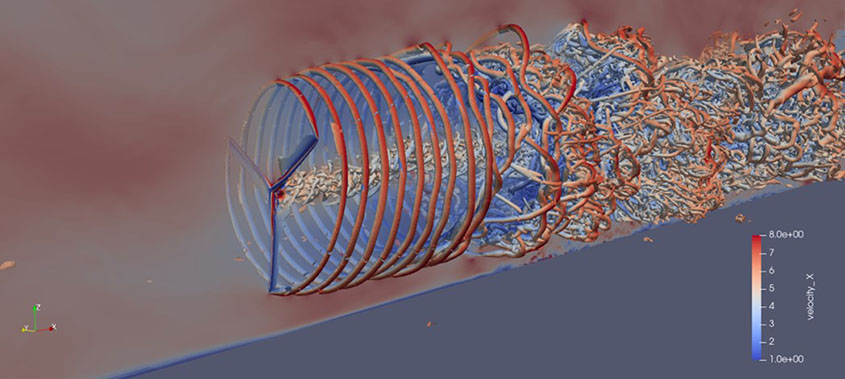
This visualization represents the flow field around a 2-MW wind turbine under turbulent inflow. NREL researchers performed this simulation using NREL's Eagle supercomputer. Image by Ganesh Vijayakumar, Shreyas Ananthan, and Michael Brazell, NREL
Distributed Generation Software Wins R&D 100 Award
NREL’s innovative Distributed Generation Market Demand (dGen™) software won an R&D 100 award from R&D World. This open-source software simulates customer adoption of distributed energy resources like solar and wind through 2050 in the United States. dGen is unique in providing a bottom-up assessment of distributed energy resource potential to the grid while embedding considerations of consumer behavior. The tool was developed by a cross-laboratory team with funding from DOE’s Wind Energy Technologies Office and Solar Energy Technologies Office.
Offshore Wind Resource Data Release Propels Wind Prospecting
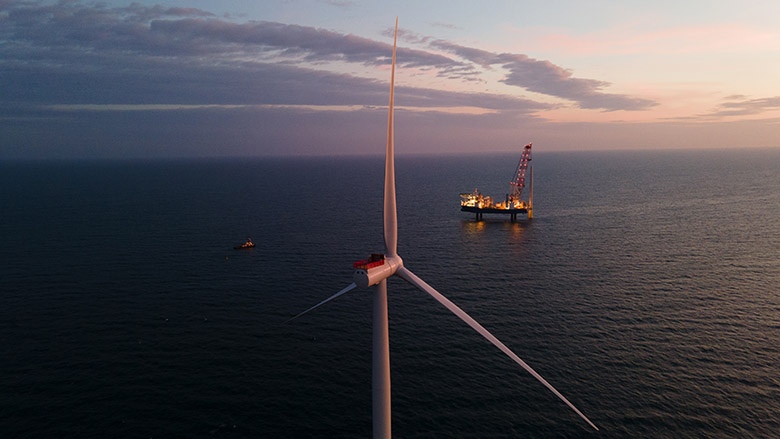
NREL’s new offshore wind datasets, which combine field observations and an enhanced ensemble modeling technique, can improve offshore wind plant site selection, design, and operational decisions. Photo from Lyfted Media for Dominion Energy
In support of national goals to develop 30 gigawatts of offshore wind energy by 2030, NREL released several new offshore wind datasets that provide wind energy developers, consultants, and researchers with high-quality U.S. wind resource data that can inform offshore wind energy siting decisions and research. Developed using a 20-year ensemble approach of state-of-the-art weather modeling tools and sophisticated resource assessment technologies, these updated datasets are available to the public on Wind Prospector, NREL’s map visualization tool.
Enhanced Tools Examine Trade-Offs Between Energy Resources in Capacity Planning
Enhanced methods and data parameters for transmission congestion modeling allow grid operators to analyze the pros and cons of different energy resources, improving grid dispatchability and resiliency. To better assess the value of long-distance wind energy transmission, NREL researchers improved the Regional Energy Deployment System (ReEDS) model based on Interconnections Seam Study findings. With upgraded capacity planning tools and grid operations model components, the ReEDS model can help grid operators gain a greater understanding of energy choke points and lead to more accurate assessments of wind’s potential contributions to the continental U.S. power grid’s reliability and resilience.
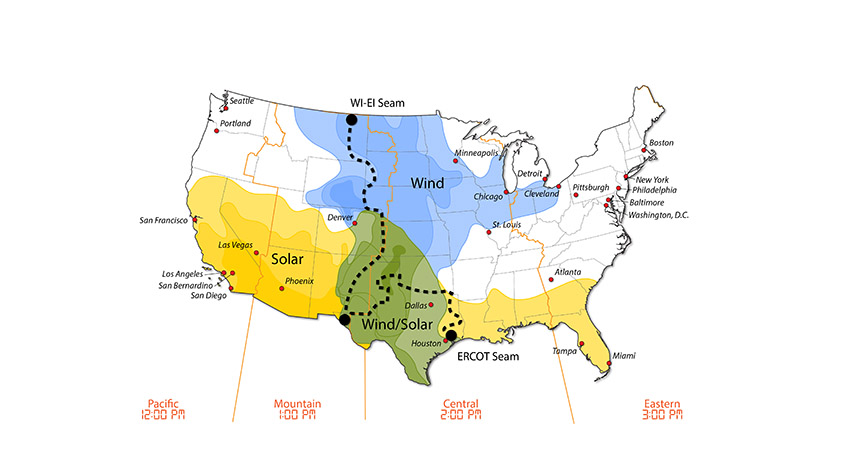
Enhanced methods for transmission congestion modeling allow grid operators to analyze trade-offs between energy resources, improving grid dispatchability and resiliency. Uniting the major regions of the U.S. power system, represented here conceptually, could enhance the ability to harness abundant renewable resources and balance loads across the country. Illustration by Billy Roberts, NREL
Grid-Scale Hybrid Power Plant Will Accelerate Transition to Renewable-Energy-Powered Electric Grid
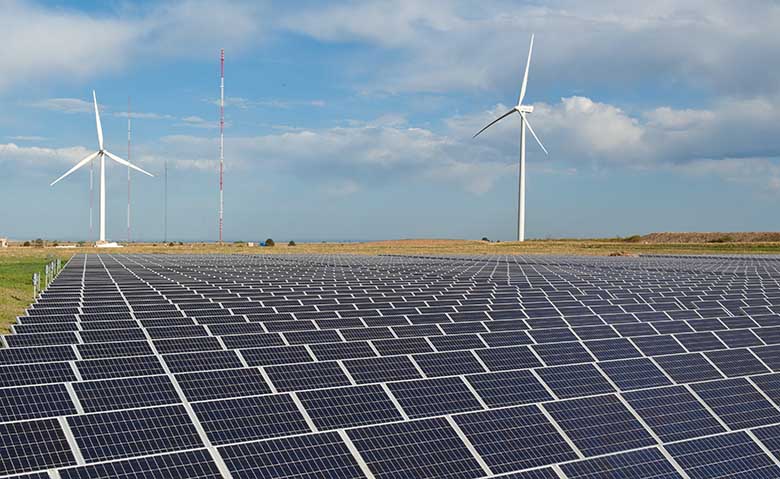
The FlexPower project will help accelerate the adoption of utility-scale variable wind and photovoltaic resources by demonstrating how hybrid power plants can provide essential reliability and resiliency services to the grid. Photo by Dennis Schroeder, NREL
NREL researchers are developing FlexPower—a variable, hybrid-generation power plant enhanced with energy storage, to be stationed at the NREL Flatirons Campus. A priority project for the Advanced Research on Integrated Energy Systems platform, FlexPower will help accelerate the adoption of utility-scale variable wind and photovoltaic resources by demonstrating how hybrid power plants can smooth the transition to an electric grid primarily powered by renewable energy. Funded by the DOE Grid Modernization Laboratory Consortium, the FlexPower project is a collaboration among NREL, Idaho National Laboratory, and Sandia National Laboratories.
ATLANTIS Projects Ensure Floating Offshore Wind Energy Technology Innovation
NREL researchers and partners also continue to work on revolutionary floating offshore wind energy projects funded under three DOE Advanced Research Projects Agency-Energy awards within the Aerodynamic Turbines Lighter and Afloat with Nautical Technologies and Integrated Servo-control (ATLANTIS) program. The two-year research projects will help ensure that innovative floating offshore wind technologies will continue to develop and expand U.S. offshore wind energy capacity by:
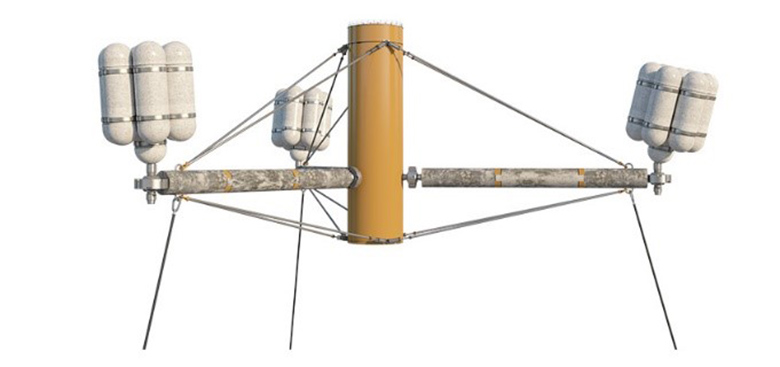
Funding from DOE’s Advanced Research Projects Agency-Energy enables NREL to develop new and potentially disruptive innovations for floating offshore wind energy technologies, like SpiderFLOAT (shown here). Graphic by Josh Bauer, NREL
- Creating an open-source software toolset called Wind Energy with Integrated Servo-control, which will enable offshore floating system engineers to design radically new systems at greatly reduced costs
- Developing the Floating Offshore-wind and Controls Advanced Laboratory, the first public floating offshore wind turbine scale-model dataset to include advanced wind turbine and hull controls, as well as hull flexibility
- Lowering floating offshore wind energy costs by simplifying the construction and maintenance logistics for deepwater wind systems. The Ultraflexible Smart FLoating Offshore Wind Turbine project leverages NREL’s innovative SpiderFLOAT technology, which features a spider-like substructure and uses innovative designs and materials best suited for the requirements of each component to make offshore wind energy systems more cost competitive.
New Resources Help Communities Realize the Benefits of Wind Energy
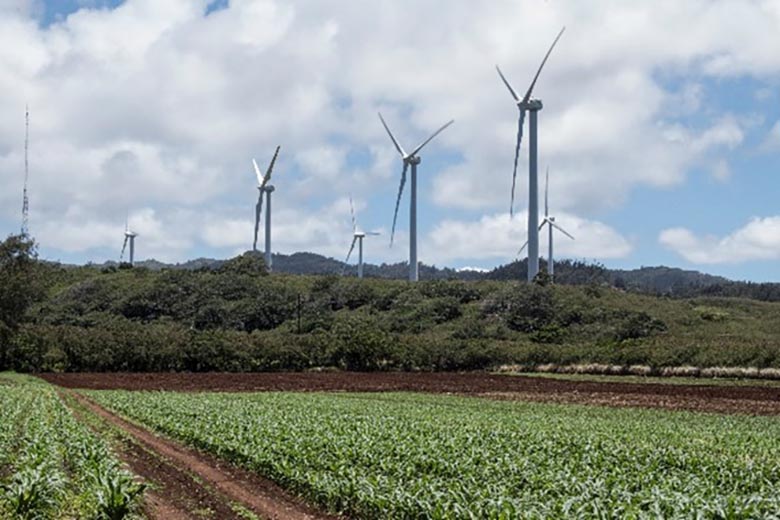
Two new WINDExchange resources developed by NREL help communities understand how wind energy projects can create jobs, increase tax revenues, provide landowner income, and generate clean, homegrown energy. Photo by Dennis Schroeder, NREL
Wind energy projects offer a wide range of benefits to nearby communities, but planning such projects can be complex. To help local decision-makers evaluate whether a wind energy project is right for their community, NREL developed two new resources: the “Land-Based Wind Energy Siting: A Foundational and Technical Resource” report and online Land-Based Wind Energy Economic Development Guide. These comprehensive, easy-to-read resources provide useful information about the siting considerations and economic opportunities associated with a potential wind energy project.
Collegiate Wind Competition Organizers Help Build the Future Wind Energy Workforce
Helping to build the future wind energy workforce, NREL organizers of the DOE Collegiate Wind Competition (CWC) facilitated the virtual 2021 event. The CWC prepares students from multiple disciplines to enter the wind energy workforce by providing real-world technology experience. This year’s contest featured 173 students from a range of disciplines, including engineering, economics, and architecture. The unique challenges of the 2021 competition gave students the opportunity to plan ahead, practice active risk management, and adapt quickly—essential skills for the wind and renewable energy industries.
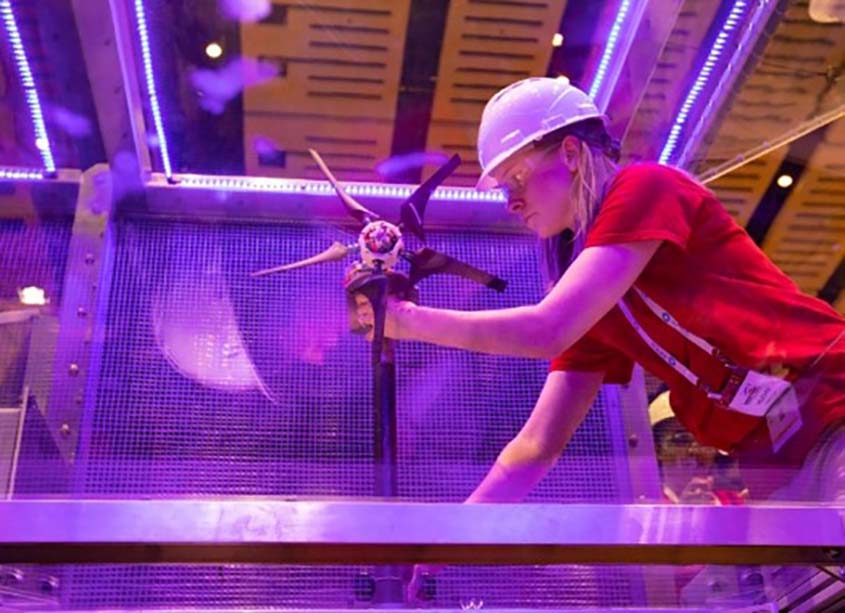
NREL organizers of the CWC integrated the theme of adaptability into the 2021 challenge, which called on teams to research, design, and build a model wind turbine for deployment in highly uncertain times with a large degree of unknown risks and delays. Photo by Werner Slocum, NREL
Machine Learning and 3D Printing Trim Fat From Tomorrow’s Generators
Three-dimensionally (3D) printed hard and soft magnets can help realize lighter wind turbine generators and enable optimized use of rare-earth elements. NREL researchers used a new software to explore an optimal magnet distribution for a 15-megawatt wind turbine generator. Compared to time-consuming existing approaches, NREL’s approach—called Manufacturing and Additive Design of Electric Machines enabled by 3D printing – advanced machine learning (MADE3D-AML)—took far less computational time. MADE3D-AML also improved the accuracy of performance predictions and further reduced costs up to 9% by helping identify a wider choice of lightweight designs with 3D-printable novel compositions for magnets.
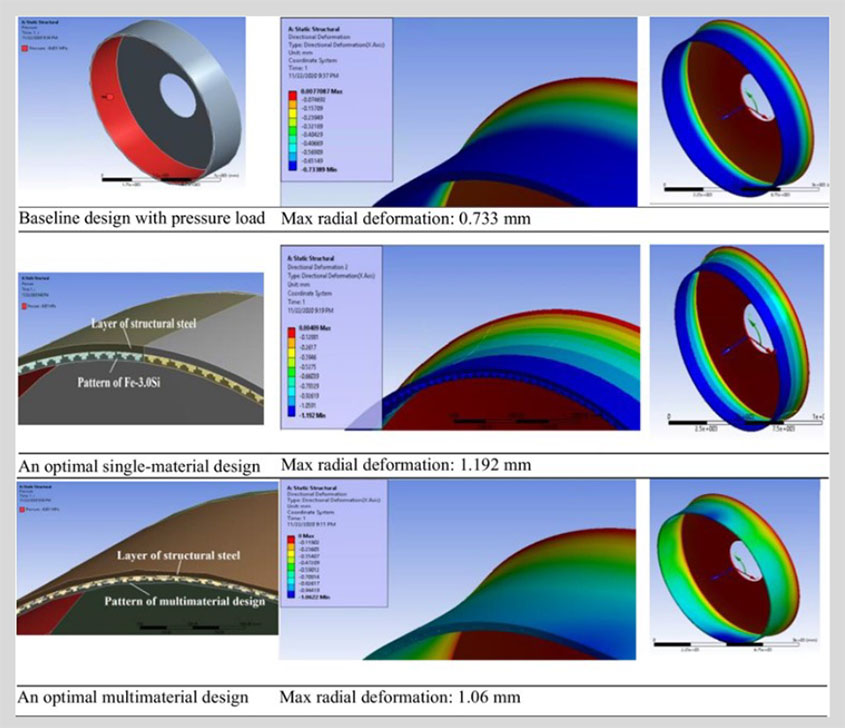
NREL is leading the charge on the design and manufacture of cost-effective, 3D-manufactured direct-drive electric generators. Image by Latha Sethuraman, NREL
Leadership Series Advances Wind Energy Science Conversation
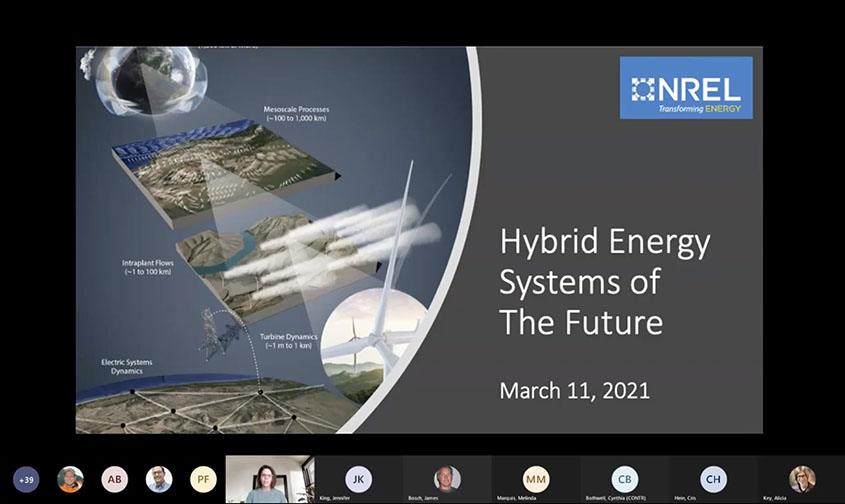
Participants in the Hybrid Energy Systems of the Future webinar discussed the design and control of the wind energy systems of the future. Screenshot by NREL
Wind Siting Interactions With U.S. Power System Evolution Prove Complex

Siting can lead to substantial differences in emissions and the cost to decarbonize the grid—and can also interact with future transmission expansion and plant design in complex ways.
A study published in Energy reveals that despite vast U.S. land-based wind resource potential, siting restrictions can have a measurable impact on future wind energy development. NREL analysts used resource potential estimates and siting constraints from a companion analysis as inputs to NREL’s publicly available Regional Energy Deployment System capacity expansion model. Studying the impacts of siting constraints ranging from open (least restrictive) to limited access (most restrictive), the researchers modeled 24 scenarios of how the U.S. electricity system might evolve from now until 2050. The results? Siting can lead to substantial differences in emissions and the cost to decarbonize the grid. This work was featured in The Wall Street Journal and Inside Climate News.
NREL Request for Proposals To Support Coexistence of Bats
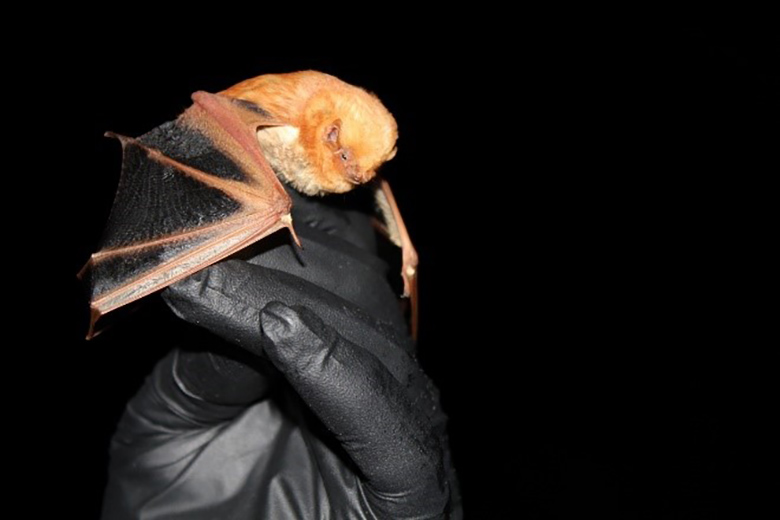
NREL requested proposals for projects that work to better understand how bats, like this red bat, interact with wind turbines and power plants and improve deterrents. The funding, which will be awarded to up to four projects, will support the coexistence of bats and wind energy. Photo by Cris Hein, NREL
Clean energy is vital to our planet’s health—and so are bats. To help wind energy projects coexist with bats, NREL in September announced a request for proposals for studying bat interactions with wind turbines and improving deterrent technology. After the request closes on Jan. 14, 2022, NREL expects to award up to four winners $450,000–$700,000 each under this competitive solicitation.
Wind Energy Research Efforts Key to Achieving a Clean Energy Future
The combination of NREL’s broad-based technical expertise, world-class capabilities, and accredited facilities has made NREL an indispensable resource for the wind industry. Wind energy research efforts like those highlighted here are critically important to NREL’s vision of achieving a clean energy future for the world—an energy future that features significant levels of reliable, affordable, and sustainable wind energy.
To understand the full sweep of NREL’s Wind Energy Program wins in 2021, read the Accomplishments and Year-End Performance Report. Learn more about NREL’s Wind Energy Program capabilities.
Last Updated May 28, 2025
